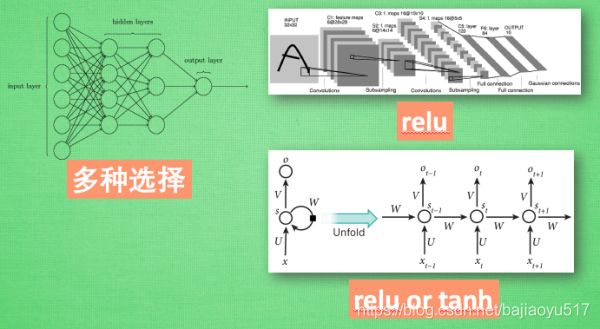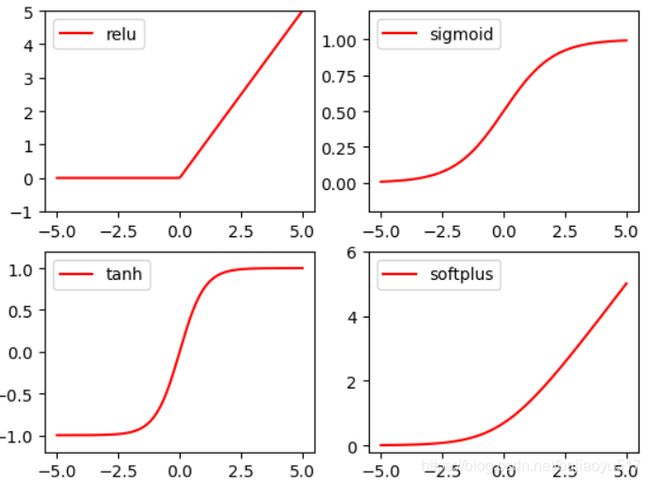【莫凡Python】Tensorflow 基础构架
1 处理结构
- Tensorflow:
首先要定义神经网络结构(数据流图 data flow graphs),再把数据 (数据以张量tensor形式存在) 放入结构中进行运算和训练。即tensor不断在一个节点flow到另一个节点。 - Tensor (张量) :
-
- 零阶张量=纯量=标量=scalar=一个数值,e.g. [1]
-
- 一维张量=向量=vector, e.g. [1, 2, 3]
-
- 二维张量=矩阵=matrix, e.g. [[1, 2, 3 ][ 4, 5, 6 ][7, 8, 9 ]]
2 例子2
目的:线性拟合 y=0.1x+0.3 , 每20步训练,输出w, b。
import tensorflow as tf
import numpy as np
# create data
x_data = np.random.rand(100).astype(np.float32)
y_data = x_data * 0.1 + 0.3
# create model
Weights = tf.Variable(tf.random_uniform([1], -1.0, 1.0))
biases = tf.Variable(tf.zeros([1]))
y = Weights * x_data + biases
# cal loss
loss = tf.reduce_mean(tf.square(y-y_data))
optimizer = tf.train.GradientDescentOptimizer(0.5)
tain = optimizer.minimize(loss)
# use model
init = tf.global_variable_initializer() #初始化之前定义的Variable
sess = tf.Session() #创建会话,用session执行init初始化步骤
sess.run(init)
# train
for step in range(200):
sess.run(train)
if step % 20 == 0:
print(step, sess.run(Weights), sess.run(biases))
3 Session 会话控制
功能:加载两个tensorflow,建立两个matrix,输出两个matrix相乘的结果。
import tensorflow as tf
# create two matrixes
matrix1 = tf.constant([[3,3]])
matrix2 = tf.constant([[2],[2]])
product = tf.matmul(matrix1, matrix2)
# method of open Session
with tf.Session() as sess:
result = sess.run(product)
print(result) #[[12]]
4 Variable 变量
在Tensorflow中,变量必须定义是用tf.Variable说明。
import numpy as np
import matplotlib.pyplot as plt
import tensorflow.compat.v1 as tf
tf.disable_v2_behavior()
v1 = tf.Variable(0,name='age') #定义变量,值为0,名字为age
c1 = tf.constant(1) #定义常量
v2 = tf.add(v1,c1)
update = tf.assign(v1,v2)
# 若定义了Variable就一定要initialize
init = tf.global_variables_initializer()
# 使用Session启动
with tf.Session() as sess:
sess.run(init)
for _ in range(3):
sess.run(update)
print(sess.run(v1))
5 Placeholder 传入值
placeholder是Tensorflow中的占位符,暂时存储变量。
Tensorflow如果想从外部传入data,需要用tf.placeholder(),然后以这种形式传输数据sess.run(**, feed_dict={input: **}).
import numpy as np
import matplotlib.pyplot as plt
import tensorflow.compat.v1 as tf
tf.disable_v2_behavior()
# 定义两个碗
input1 = tf.placeholder(tf.float32)
input2 = tf.placeholder(tf.float32)
output = tf.multiply(input1,input2)
with tf.Session() as sess:
print(sess.run(output,feed_dict={
input1:[3.],input2:[8.]})) # [24.]
6 什么是激励函数 (Activation Function)
7 激励函数 Activation Function
import tensorflow as tf
import numpy as np
import matplotlib.pyplot as plt
# fake data
x = np.linspace(-5, 5, 200) # x data, shape=(100, 1)
# following are popular activation functions
y_relu = tf.nn.relu(x)
y_sigmoid = tf.nn.sigmoid(x)
y_tanh = tf.nn.tanh(x)
y_softplus = tf.nn.softplus(x)
# y_softmax = tf.nn.softmax(x) softmax is a special kind of activation function, it is about probability
sess = tf.Session()
y_relu, y_sigmoid, y_tanh, y_softplus = sess.run([y_relu, y_sigmoid, y_tanh, y_softplus])
# plt to visualize these activation function
plt.figure(1, figsize=(8, 6))
plt.subplot(221)
plt.plot(x, y_relu, c='red', label='relu')
plt.ylim((-1, 5))
plt.legend(loc='best')
plt.subplot(222)
plt.plot(x, y_sigmoid, c='red', label='sigmoid')
plt.ylim((-0.2, 1.2))
plt.legend(loc='best')
plt.subplot(223)
plt.plot(x, y_tanh, c='red', label='tanh')
plt.ylim((-1.2, 1.2))
plt.legend(loc='best')
plt.subplot(224)
plt.plot(x, y_softplus, c='red', label='softplus')
plt.ylim((-0.2, 6))
plt.legend(loc='best')
plt.show()



